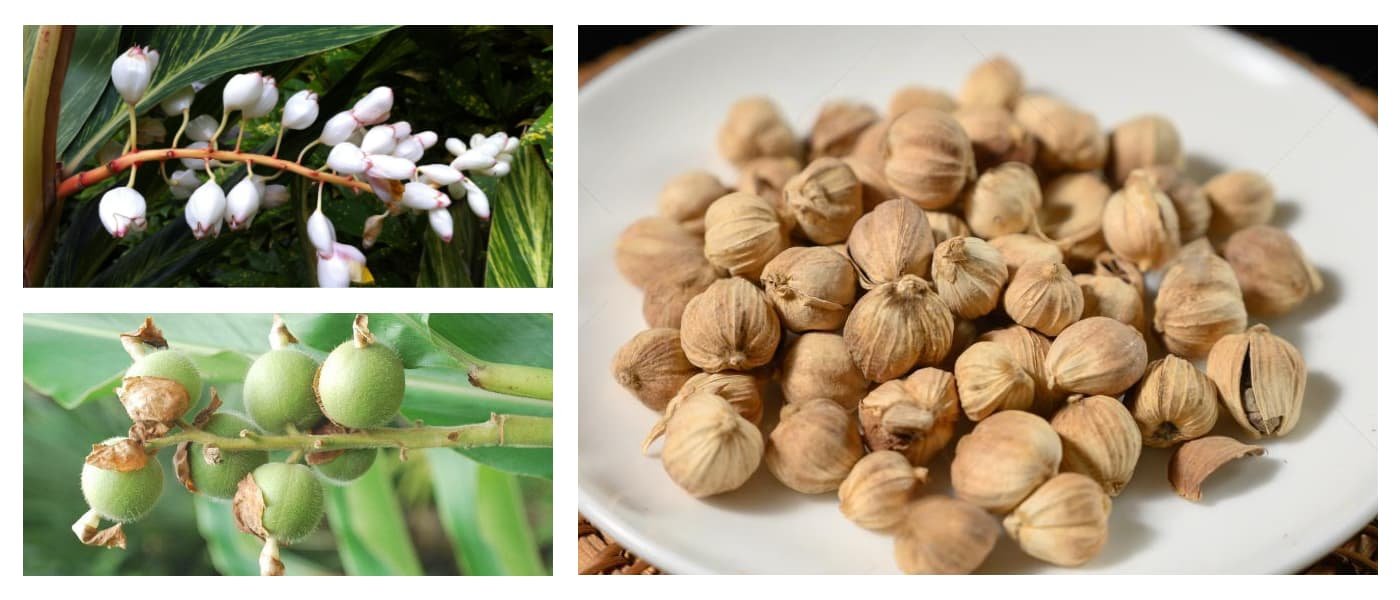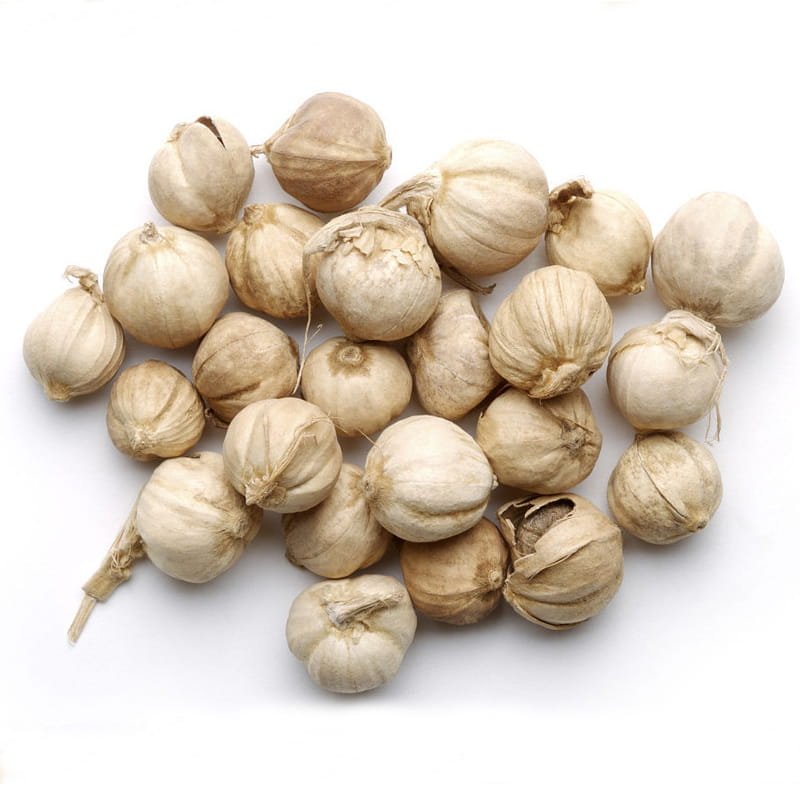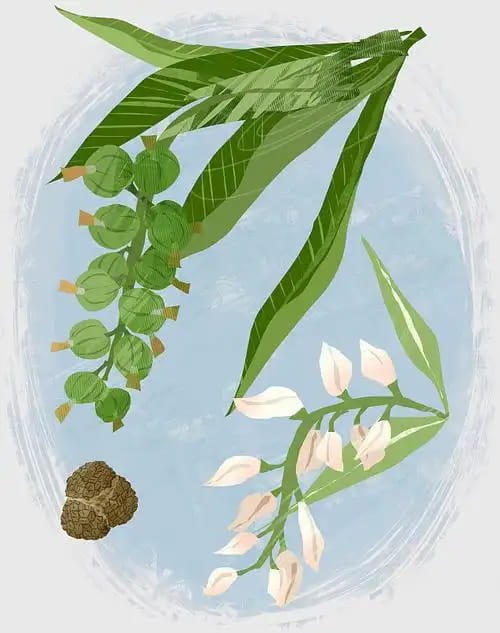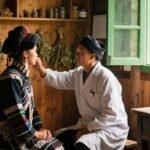White Cardamom (Bai Dou Kou, Amomum kravanh)

What is White Cardamom (Bai Dou Kou)?
White cardamom, known in Chinese as Bai Dou Kou, is the dried ripe fruit of Amomum kravanh, a plant from the ginger family. It gets its name from its pale, smooth outer shell. In Traditional Chinese Medicine (TCM), it is a frequently used aromatic herb for resolving dampness, promoting digestion, and relieving nausea. Warm in nature and pungent in taste, it mainly enters the spleen, stomach, and lung meridians. White cardamom is used both medicinally and culinarily.
What Are the Benefits of White Cardamom(Bai Dou Kou)?
Traditional Uses
- Aromatically transforming dampness:
Treats poor appetite, bloating, sticky saliva, and bad breath caused by damp accumulation; - Warming the middle and stopping nausea:
Especially effective for nausea and vomiting due to cold in the stomach or damp stagnation; - Calming pregnancy-related nausea:
Sometimes used to ease morning sickness (only under medical supervision); - Treating external dampness-related illnesses:
Relieves symptoms like dizziness and fatigue caused by summer heat and damp weather.
Modern Pharmacological Effects
- Antibacterial and Antifungal Activity
The volatile oils in White Cardamom, especially compounds like 1,8-cineole and terpenes, exhibit strong inhibitory effects against bacteria and fungi such as Staphylococcus aureus and Candida albicans. This suggests potential use in managing infections like oral inflammation or gastrointestinal issues.
- Digestive Stimulation and Gastrointestinal Motility
Studies show that extracts of White Cardamom can stimulate gastric juice and digestive enzyme secretion while enhancing smooth muscle contraction in the gastrointestinal tract. This makes it effective for relieving symptoms such as bloating, poor appetite, and indigestion.
- Antioxidant and Free Radical Scavenging
Rich in essential oils, flavonoids, and polyphenols, White Cardamom has strong antioxidant properties that help neutralize free radicals, thereby protecting cells from oxidative stress and slowing the aging process.
- Anti-inflammatory and Analgesic Effects
Research indicates that compounds in White Cardamom suppress the synthesis of inflammatory mediators such as prostaglandin E2 (PGE2), thereby reducing inflammation and pain. It is especially helpful for managing conditions like gastritis, enteritis, or cold-induced abdominal pain.
- Potential Anti-Tumor Properties (Preliminary)
Preliminary in vitro studies suggest that certain compounds in White Cardamom may induce apoptosis and inhibit the proliferation of cancer cells, including liver, gastric, and breast cancer cell lines. However, these findings are still at an early stage and require further clinical confirmation.
- Nervous System Regulation and Anti-Anxiety
Some studies have found that the aromatic compounds in White Cardamom have a mild calming effect on the central nervous system, helping to relieve tension, anxiety, and mild insomnia. It is often used in aromatherapy for this reason.
How to Use White Cardamom (Bai Dou Kou)
How to use: Typically taken in decoctions, powders, or pills. It can also be ground into powder and steeped in hot water, or added to food like porridge. Modern applications include essential oils and aromatherapy products.
Recommended dosage: Usually 3–6 grams per dose. When preparing as a decoction, it should be added in the last 5 minutes to preserve its aromatic compounds. Dosage should be adjusted under the guidance of a TCM practitioner.

White Cardamom (Bai Dou Kou) Precautions and Side Effects
- Caution for people with internal heat:
Those with symptoms like dry mouth, red tongue, and scanty tongue coating should use it cautiously; - Pregnancy use:
Though it may relieve nausea, it must be used under professional guidance; - Overconsumption risks:
May cause dry mouth or constipation if taken excessively;
References on Amomum kravanh (White Cardamom)
Amomum kravanh Phytochemistry and Constituents
1. Xiong HM, Li HY, Lin ZR, Liu XM, Bai LP, Zhang W, Jiang ZH, Zhu GY. Chemical Constituents from the Fruits of Amomum kravanh and Their Role in Activating Alcohol Dehydrogenase. Molecules. 2023;28(12):4878.
View Article
2. Vihanova K, Urbanova K, Nguon S, Kokoska L. Chemical Composition of Essential Oils and Supercritical Carbon Dioxide Extracts from Amomum kravanh, Citrus hystrix and Piper nigrum ‘Kampot’. Molecules. 2023;28(23):7748.
View Article
3. Yin H, Luo JG, Kong LY. Tetracyclic diterpenoids with isomerized isospongian skeleton and labdane diterpenoids from the fruits of Amomum kravanh. J Nat Prod. 2013;76(2):237-242.
View Article
4. Luo JG, Yin H, Kong LY. Monoterpenes from the fruits of Amomum kravanh. J Asian Nat Prod Res. 2014;16(5):471-475.
View Article
5. Zhang JS, Cao XX, Zhang H. Chemical constituents from the fruits of Amomum kravanh. Biochem Syst Ecol. 2020;92:104127.
View Article
6. Zhang JS, Cao XX, Yu JH, Yu ZP, Zhang H. Diarylheptanoids with NO production inhibitory activity from Amomum kravanh. Bioorg Med Chem Lett. 2020;30(8):127026.
View Article
7. Feng X, Jiang ZT, Wang Y, Li R. Composition comparison of essential oils extracted by hydrodistillation and microwave-assisted hydrodistillation from Amomum kravanh and Amomum compactum. J Essent Oil Bear Plants. 2011;14(3):354-359.
View Article
8. Yothipitak W, Boonnoun P, Goto M, Shotipruk A, Tonanon N. Response surface methodology to supercritical carbon dioxide extraction of essential oil from Amomum krervanh Pierre. Sep Sci Technol. 2009;44(16):3923-3936.
View Article
9. Wu HQ, Huang XL, Lin XS, Huang F, Ge FH. [Analysis of the essential oils from Amomum kravanh Pierre ex Gagnep by GC-MS]. Zhong Yao Cai. 2006;29(8):788-792. (Article in Chinese)
View Article
Amomum kravanh Pharmacology and Bioactivities
1. Diao WR, Zhang LL, Feng SS, Xu JG. Chemical composition, antibacterial activity, and mechanism of action of the essential oil from Amomum kravanh. J Food Prot. 2014;77(10):1740-1746.
View Article
2. Li Q, Zhang LL, Xu JG. Antioxidant, DNA damage protective, antibacterial activities and nitrite scavenging ability of essential oil of Amomum kravanh from China. Nat Prod Res. 2021;35(23):5415-5419.
View Article
3. Weerapol Y, Manmuan S, Chaothanaphat N, Okonogi S, Limmatvapirat C, Limmatvapirat S, Tubtimsri S. Impact of fixed oil on Ostwald ripening of anti-oral cancer nanoemulsions loaded with Amomum kravanh essential oil. Pharmaceutics. 2022;14(5):938.
View Article
4. Tangjitjaroenkun J, Tangchitcharoenkhul R, Yahayo W, Supabphol S, Sappapan R, Supabphol R. Chemical compositions of essential oils of Amomum verum and Cinnamomum parthenoxylon and their in vitro biological properties. J Herbmed Pharmacol. 2020;9(3):226-233.
View Article
5. Liu C, Cheng X, Hao W, Yu S, Sun Y, Wang J. Nephroprotective effects of Amomum kravanh essential oil by inhibition of ferroptosis via Nrf2/HO-1 signaling in adenine- and 5/6 nephrectomy-induced chronic kidney disease. Phytomedicine. 2025; (in press).
View Article
6. Xiong HM, Li HY, Lin ZR, Liu XM, Bai LP, Zhang W, et al. (see Reference 1 in Phytochemistry) – Isolated compounds from Amomum kravanh enhanced alcohol dehydrogenase activity in vitro, suggesting a potential hangover-relief effect.
View Article
7. Zhang JS, Cao XX, Yu JH, Yu ZP, Zhang H. (see Reference 6 in Phytochemistry) – Several diarylheptanoids from A. kravanh showed moderate inhibition of nitric oxide production in LPS-activated macrophages (IC50 ~17–26 μM).
View Article
Amomum kravanh Clinical and Applied Studies
1. Chen XL, Feng SS, Zhang K. Effect of Amomum kravanh volatile oil on the expression of caspase-3, Bax, Bcl-2 and NF-κB p65 in kidney tissues of rats with gentamicin-induced acute kidney injury. J Shihezi Univ (Natural Sci). 2020;38(5):629-634. (Article in Chinese)
View Article
2. Chen HM, Wang XL, Enhe SR. Effect of Amomum kravanh Pierre ex Gagnep on the expression of TGF-β1 and PAI-1 in adriamycin-induced renal injury rats. Pharmacol Clin Chin Med. 2017;33(3):105-108. (Article in Chinese)
View Article
3. Chaimanee V, Warrit N, Boonmee T, Pettis JS. Acaricidal activity of essential oils for the control of honeybee (Apis mellifera) mites Tropilaelaps mercedesae under laboratory and colony conditions. Apidologie. 2021;52:561-575.
View Article
4. Cai R, Yue X, Wang Y, Yang Y, Sun D, Li H, Chen L. Chemistry and bioactivity of plants from the genus Amomum. J Ethnopharmacol. 2021;281:114563.
View Article
5. Wu MH, Zhang W, Guo P, Li L, Mo ZX, Zhao ZZ. Identification of seven Zingiberaceous species based on comparative anatomy of microscopic characteristics of seeds (including A. kravanh). Chin Med. 2014;9:10.
View Article
6. Diao WR, Zhang LL, Feng SS, Xu JG. (see Reference 1 in Pharmacology) – Demonstrated the potential of A. kravanh essential oil as a natural food preservative by inhibiting foodborne bacteria and damaging their cell membranes.
View Article
7. (Reserved for additional clinical or applied studies if available)
View Article
Chinese Materia Medica (Zhong Hua Ben Cao): White Cardamom (Bai Dou Kou)

Other Names: Duo Gu, Ke Kou, Bai Kou, Yuan Dou Kou, Kou Mi, Dou Kou
Historical Record:
White Cardamom was first recorded in the Kai Bao Materia Medica (Kai Bao Ben Cao) as “Duo Gu,” said to originate from the country of Jia Gu Luo. It was described as a plant resembling a banana, with leaves similar to Acorus, pale yellow flowers, and fruit that starts green and turns white upon ripening. It is harvested in July. The Supplements to the Classic of Materia Medica (Ben Cao Shi Yi) also mentions it, under names such as Duo Gu, Ke Kou, and Bai Kou.
Source:
Botanical origin: the dried ripe fruit of Alpinia tonkinensis Gagnep., a plant in the ginger family (Zingiberaceae).Harvest and processing: Collected when nearly ripe, then dried by heating or in shade.
Habitat and Distribution:
Ecological environment: Grows in warm, humid, humus-rich forest undergrowth with good drainage and fertility.
Geographic distribution: Native to Cambodia and Thailand; cultivated in small quantities in Yunnan and Guangdong, China.
Botanical Description:
Alpinia tonkinensis is a perennial erect herb with stout stems. Leaf stalks are 3–6 cm long; ligules 1.5–2 cm, leathery and blunt; leaf sheaths striated. Leaf blades are lanceolate, up to 60 cm long and 7 cm wide, tapering at both ends, leathery and glabrous on both surfaces. Inflorescences are terminal, erect panicles 40–50 cm long, about 4 cm wide, with hairless lower portions and upper portions densely hairy. Flowers occur in clusters of 3–5, with very short pedicels. Bracts and bracteoles are ovate and deciduous. Calyx is nearly bell-shaped, 9–10 mm long with irregular teeth at the apex, splitting on one side. Corolla tube is 7–8 mm long; lobes are elliptic, 1.5–1.8 cm long, concave, with hairs on the back. The labellum is ovate or round, 1.4 cm long, 1–1.2 cm wide, slightly notched at the apex. Staminodes are short and linear; filaments are 4–5 mm long, anthers 6 mm long. Ovary is spherical, covered with silky hairs. Flowering: February–March; fruiting: April–June.
Identification:
- Macroscopic:
Capsules are oblong, 1.2–1.6 cm long, yellow-brown and smooth. Each capsule contains 3 chambers, each with 4–8 seeds. Inner and outer seed coats adhere closely, making seeds hard to separate. Seeds are irregular polyhedrons about 6 mm in diameter, light brown with longitudinal striations. Aril is white. Odor faint; taste pungent and bitter.
- Microscopic:
Cross-section of pericarp shows an outer epidermis of square cells; mesocarp contains stone cells with radial elongation and conspicuous pits; scattered vascular bundles and parenchyma cells with small crystals. Aril consists of multiple cell layers, the outermost being elongated with blunt ends. Calcium oxalate crystal clusters visible.
Seed Identification:
Cross-section triangular or trapezoidal. Aril has several layers of tangentially elongated cells. Testa epidermis consists of radially elongated cells (40–90 μm long, 10–45 μm wide), with a cuticle. Hypodermis consists of one layer with reddish pigments. Oil cells form one layer, cylindrical, 26 μm long, 21 μm wide, with silica bodies. Endosperm contains starch granules and calcium oxalate crystals. Embryo cells contain starch and oil droplets.
Nature and Flavor:
Pungent in flavor, warm in nature.
Functions and Indications:
- Transforms dampness and regulates Qi
- Warms the middle and stops vomiting
- Stimulates appetite and aids digestion
Indicated for damp stagnation, spleen-stomach disharmony, epigastric bloating, poor appetite, early-stage damp-warm disease, chest oppression, cold stomach with vomiting, and food accumulation.
Usage and Dosage:
Internal decoction: 3–9 grams
Cautions:
Use with caution in patients with Yin deficiency and blood dryness.
Commentaries from Classical Texts:
- Compendium of Materia Medica (Ben Cao Gang Mu), Li Shizhen:
“Treats epidemic malaria, cold-type intermittent fever, heatstroke-induced vomiting and diarrhea, esophageal obstruction, acid reflux, phlegm accumulation, gynecological disorders, dispels cold and dampness, relieves stagnation, and neutralizes fish and meat toxins.”
- Kai Bao Materia Medica (Kai Bao Ben Cao), Liu Han:
“Descends Qi, stops cholera, relieves all cold Qi, and detoxifies alcohol.”
- Additional Records (Bie Lu), Liu Xiang:
“Warms the center, relieves abdominal pain and vomiting, and eliminates bad breath.”
- Mystical Pearl of Red Water (Chi Shui Xuan Zhu):
“For cold-type stomach vomiting and pain: White Cardamom kernel 9g, powdered and taken with wine.”
- Emergency Prescriptions on Hand (Sui Shen Bei Ji Fang):
“For cold stomach with vomiting after eating: White Cardamom seed (3 pieces), pounded and sieved, mixed with a warm cup of good wine, drink 2–3 cups.”
- Formulas for Universal Relief (Bo Ji Fang》):
“For Spleen-Stomach Qi disharmony with diarrhea and dysentery: White Cardamom 60g (half raw, half cooked), Immature Bitter Orange 250g (boiled in sour water and stir-fried), Cinnamon Twig 60g, Aged Tangerine Peel 60g (stir-fried and finely cut), Chebula 60g (half raw, half cooked), Angelica 60g (washed). Grind into fine powder. Take 3g per dose with ginger and jujube decoction. To make pills: cook jujube in sour water, remove skins and pits, mash into paste, form pills the size of a Chinese date seed. Fry sliced ginger until black, decoct in water, and take 15 pills.”
- Family Prescriptions of the Wei Clan (Wei Shi Jia Cang Fang):
“For Qi obstruction in the Spleen-Stomach causing anorexia: White Cardamom kernel and Tsaoko Cardamom, each 60g, aged rice 180g (rinsed and stir-fried), Clove 15g (not roasted). Grind to powder, make pills with jujube paste, size of a red bean. Take 50–100 pills with rice water.”
- Wuhan Medical and Health Journal (1959, Issue 3):
“For pregnancy vomiting: White Cardamom 3g, Bamboo Shavings 9g, Jujube 3 pieces, Fresh Ginger 3g. Crush ginger for juice, decoct the other three ingredients, filter, mix with ginger juice, and drink.”
- Effective Formulas from Generations of Physicians (Shi Yi De Xiao Fang):
“For pediatric vomiting and cold stomach: White Cardamom kernel (14 pieces), Tsaoko Cardamom (14 pieces), raw Licorice 6g, roasted Licorice 6g. Grind to powder and sprinkle in the child’s mouth regularly.”
- Shen’s Longevity Manual (Shen Shi Zun Sheng Shu,):
“For vomiting and belching: White Cardamom, Patchouli, Pinellia, Tangerine Peel, Fresh Ginger—decoct in water.”
- Qiankun Medical Practice (Qian Kun Sheng Yi):
“For postpartum hiccups: White Cardamom and Clove, 15g each. Grind to powder. Take 3g with Peach Kernel Decoction. Repeat as needed.”The information provided on this page regarding traditional Chinese medicinal herbs is for educational and informational purposes only. It is not intended as medical advice, diagnosis, or (used in traditional contexts).



Leave a Reply